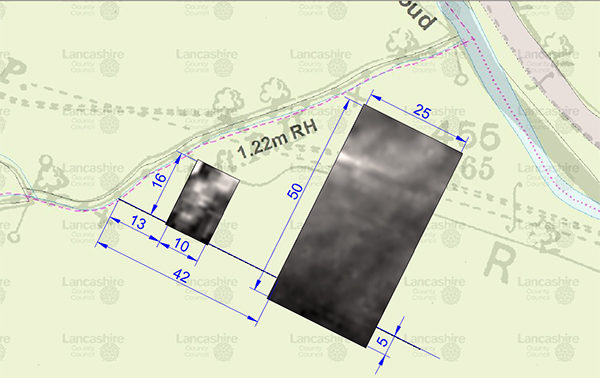
Last month our small intrepid field team made another visit to the Fylde to help the Wyre group with another resistivity survey. This time it was on a suspected Roman road which is thought to have run from Ribchester to Lancaster. The route is well defined out of Ribchester up the hill at Longridge, but beyond the fell the route is more speculative. However, a line is shown on the revised 1845 6 inch OS map. At Withinreap Farm just north of Longridge there is a seemingly unnecessary loop in the road, but on the map, the line representing the Roman road, goes straight across. There is a bridge crossing the River Loud at this point and it has been suggested that flooding may have damaged the original route making it necessary for a slight diversion.
When we arrived on site we could see a distinct terrace on the suspected line just to the south of the bridge with a small ridge on the south side. The terrace on the west side is terminated by a brook which enters the river on its south side. It was obvious that some erosion of the terrace had occurred due to this brook but there was no sign of stones in the eroded bank. The land belongs to Withinreap Farm and it was a local enthusiast Neil Ayers, a relative of the famer, who had asked the Wyre Group if they would investigate the terrace feature. Although there were no stones in the bank at this point, there were plenty in the brook and Neil pointed out another bank just a few metres upstream were plenty of stones protrude from the clay soil. Neil said he had also found what appeared to be pieces of iron slag here. The stone in the bank had previously been reported in a booklet by Graystone, a local historian who has researched the Roman roads in this area. The stony bank also seemed to line up more with the field boundary which cuts across the loop on the other side of the brook.

The boundary/stony bank alignment differed from the terrace alignment. However, as we only had permission to work in the field with the terrace in, our first survey was carried out to see if boundary/stony bank alignment continued across the field. We also positioned our 50m x 25m survey area over the bank and terrace to see if anything could be detected here as well. As you can see from the results, nothing came up in the field on the boundary/stony bank alignment, but the terrace showed quite a significant high-res area suggesting a cobbled surface.
For comparison we also complete a smaller (16m x 10m) survey over the stony bank area. This also showed significant high-res but the alignment is not necessarily in the direction of the boundary. In fact it looks to be heading toward the terrace but cut short by the erosion. If this is the case it would certainly cast some doubt on the alignment being of Roman origin. Neil is hoping that the Wyre Group will be able to carry out some excavations in the near future which should provide conclusive proof. However our efforts will prove useful in giving them some targets to aim for.

Next Meeting
Wednesday 1st October - in the Standish Suite at the Brocket Arms (7.30pm as usual). For our talk this month, David Hampson from the Wyre Archaeological Group has agreed to come and tell us about some of the interesting projects they have been carrying out over the years on the Fylde. In particular excavations at Bourne Hill where we helped them with a resistivity survey earlier in the year. They have also been looking at the Roman roads - the one mentioned above and also Dane's Pad which runs past the Roman Fort at Kirkham. Lately they have been working on a corn mill which is of interest to us as we have excavated two mills in the Wigan area (reported on in our website projects area). Significantly they have found old kiln tiles very similar to the ones we discovered. Hope to see you at the meeting, BA.
|



